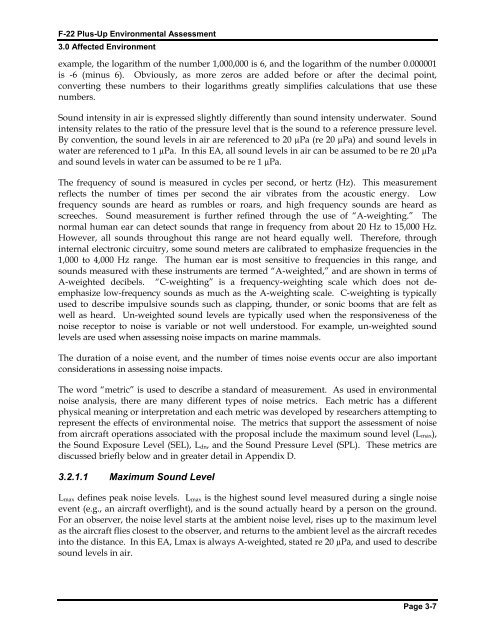F-22 Plus-Up Environmental Assessment - Joint Base Elmendorf ...
F-22 Plus-Up Environmental Assessment - Joint Base Elmendorf ...
F-22 Plus-Up Environmental Assessment - Joint Base Elmendorf ...
You also want an ePaper? Increase the reach of your titles
YUMPU automatically turns print PDFs into web optimized ePapers that Google loves.
F-<strong>22</strong> <strong>Plus</strong>-<strong>Up</strong> <strong>Environmental</strong> <strong>Assessment</strong><br />
3.0 Affected Environment<br />
example, the logarithm of the number 1,000,000 is 6, and the logarithm of the number 0.000001<br />
is -6 (minus 6). Obviously, as more zeros are added before or after the decimal point,<br />
converting these numbers to their logarithms greatly simplifies calculations that use these<br />
numbers.<br />
Sound intensity in air is expressed slightly differently than sound intensity underwater. Sound<br />
intensity relates to the ratio of the pressure level that is the sound to a reference pressure level.<br />
By convention, the sound levels in air are referenced to 20 µPa (re 20 µPa) and sound levels in<br />
water are referenced to 1 µPa. In this EA, all sound levels in air can be assumed to be re 20 µPa<br />
and sound levels in water can be assumed to be re 1 µPa.<br />
The frequency of sound is measured in cycles per second, or hertz (Hz). This measurement<br />
reflects the number of times per second the air vibrates from the acoustic energy. Low<br />
frequency sounds are heard as rumbles or roars, and high frequency sounds are heard as<br />
screeches. Sound measurement is further refined through the use of “A-weighting.” The<br />
normal human ear can detect sounds that range in frequency from about 20 Hz to 15,000 Hz.<br />
However, all sounds throughout this range are not heard equally well. Therefore, through<br />
internal electronic circuitry, some sound meters are calibrated to emphasize frequencies in the<br />
1,000 to 4,000 Hz range. The human ear is most sensitive to frequencies in this range, and<br />
sounds measured with these instruments are termed “A-weighted,” and are shown in terms of<br />
A-weighted decibels. “C-weighting” is a frequency-weighting scale which does not deemphasize<br />
low-frequency sounds as much as the A-weighting scale. C-weighting is typically<br />
used to describe impulsive sounds such as clapping, thunder, or sonic booms that are felt as<br />
well as heard. Un-weighted sound levels are typically used when the responsiveness of the<br />
noise receptor to noise is variable or not well understood. For example, un-weighted sound<br />
levels are used when assessing noise impacts on marine mammals.<br />
The duration of a noise event, and the number of times noise events occur are also important<br />
considerations in assessing noise impacts.<br />
The word “metric” is used to describe a standard of measurement. As used in environmental<br />
noise analysis, there are many different types of noise metrics. Each metric has a different<br />
physical meaning or interpretation and each metric was developed by researchers attempting to<br />
represent the effects of environmental noise. The metrics that support the assessment of noise<br />
from aircraft operations associated with the proposal include the maximum sound level (L max),<br />
the Sound Exposure Level (SEL), L dn, and the Sound Pressure Level (SPL). These metrics are<br />
discussed briefly below and in greater detail in Appendix D.<br />
3.2.1.1 Maximum Sound Level<br />
L max defines peak noise levels. L max is the highest sound level measured during a single noise<br />
event (e.g., an aircraft overflight), and is the sound actually heard by a person on the ground.<br />
For an observer, the noise level starts at the ambient noise level, rises up to the maximum level<br />
as the aircraft flies closest to the observer, and returns to the ambient level as the aircraft recedes<br />
into the distance. In this EA, Lmax is always A-weighted, stated re 20 µPa, and used to describe<br />
sound levels in air.<br />
Page 3-7
















